Web development has faced numerous advancements, especially as applications become more complex to satisfy user expectations, address security concerns, and integrate with other systems. Unlike traditional monolithic frontends, which present challenges in terms of maintenance and scalability, micro frontends break down the entire user interface (UI) into smaller, more manageable modules.
At Aloa, we are well aware of the complexities of micro frontends. Our robust project management and expert partners are ideal for implementing and scaling micro frontend architectures for seamless integration and performance. With a dedicated U.S.-based Product Owner overseeing every detail, Aloa tailors solutions that harness the full potential of micro frontend technology.
Leveraging our expertise in handling a wide range of advanced software solutions, this blog will cover how micro frontends work, explore integration techniques, and explain why adopting them can boost your project’s flexibility and performance. By the end, you’ll be ready to take full advantage of this innovative solution in your product builds.
Let’s get started!
How Micro Frontends Work
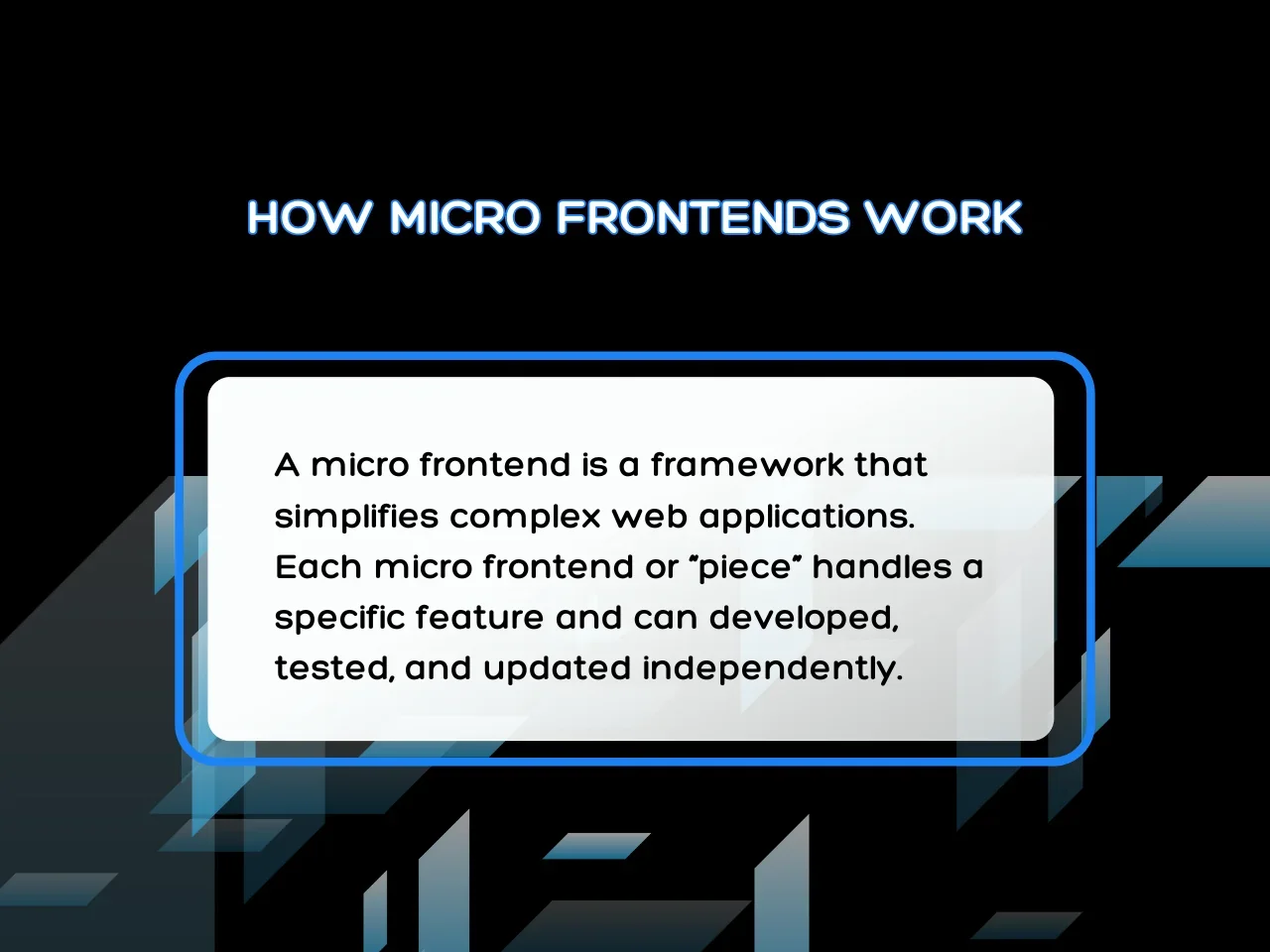
A micro frontend is a framework that simplifies complex web applications. Each micro frontend or “piece” focuses on a specific feature and operates independently in terms of development, testing, and updates. This enables concurrent work by QA, operations, and frontend development teams without impeding each other’s progress.
Typically, each micro frontend is often hosted on its domain or subdomain and communicates with others through APIs or other methods for seamless sharing of data and functionality. An orchestrator, often a JavaScript file, coordinates the integration of these components into a single application, similar to the concept of microservices but applied to the front end.
At the core of a micro frontend setup is the shell application, responsible for loading and coordinating different micro frontends, managing routing, and providing a unified look while allowing each micro frontend to operate independently.
Breaking Down the Application into Smaller, Manageable Pieces
Micro frontends are similar to dividing a large, complicated web application, such as an online shopping site or a social media platform, into smaller, easy-to-manage sections. These sections handle a specific feature, like a shopping cart, news feed, or user profiles.
Each section, or micro frontend, has its tools and updates, so changes in one part don’t affect the whole application. If something goes wrong, independent teams can quickly find and fix the issue. It’s easier to update or roll back individual sections, which helps the team work better together and make the app more scalable.
Incorporating Vue.js in these sections can further streamline development. Vue's component-based architecture helps manage the Document Object Model (DOM) efficiently within each micro frontend, ensuring that updates and changes are localized and don’t impact other parts of the application.
Additionally, the reduced code volume within a single micro frontend makes it easier to manage and less susceptible to mistakes. This results in long-term cost savings and gives finance managers better budget control while meeting specific business requirements.
Communication between Micro Frontends: Strategies and Challenges
Effective communication and data sharing are essential for micro frontends to work well together. Shared state management, event-driven architectures, and APIs are some of the techniques that can ensure all components are synchronized and function smoothly.
Establish clear contracts and communication protocols between micro frontends to avoid conflicts. This involves defining how different parts of the application will interact through APIs, events, and shared data models. For example, importing components from one micro frontend to another using a syntax like import { thing } from 'other-micro frontend' helps maintain clear communication.
Integrating micro frontends can be complex, especially when different parts of the app need to interact. However, with the right approach, it is manageable. In some cases, separate pages may need to communicate minimally—like notifying each other of user actions or triggering updates. To handle this, teams can create common components, develop a shared style guide, or maintain open lines of communication to coordinate their efforts effectively.
Ensuring Security in Micro Frontend Architecture
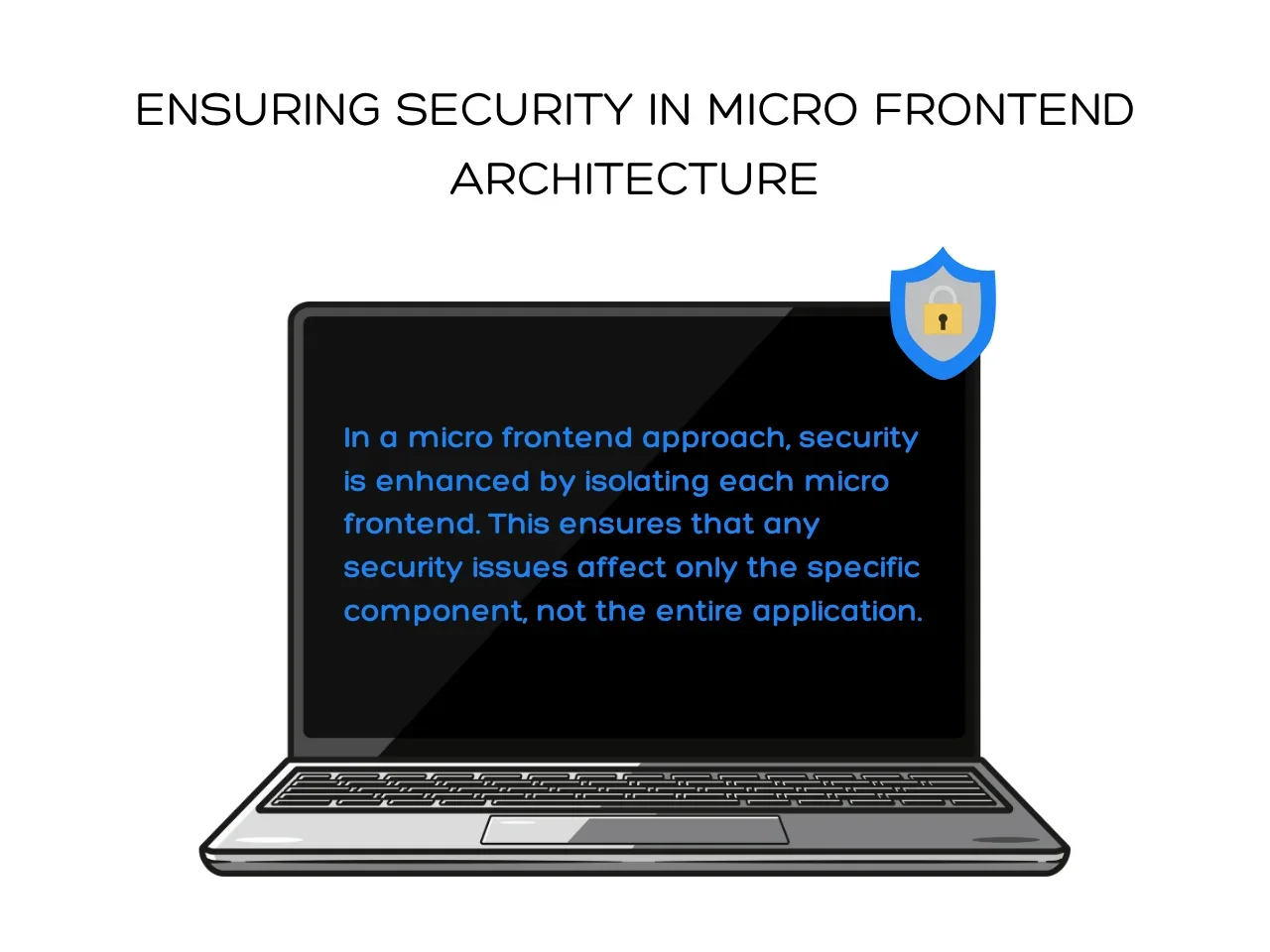
In a micro frontend approach, security is enhanced by isolating each micro frontend. This ensures that any security issues affect only the specific component, not the entire application.
Strict API contracts and authentication mechanisms are essential for safe communication between components. Consider using secure coding best practices like input validation and output encoding. Then, conduct regular security audits, such as penetration testing and vulnerability assessments, to identify and address potential security weaknesses.
Maintaining Performance in Micro Frontend Architecture
Monitoring performance and tracking dependencies between micro frontends are essential for smooth operation and identifying potential issues. Tools like New Relic, Datadog, and Sentry can be very helpful in this process. For example, transitioning from a monolithic application to micro frontends may take up to two years, but it often leads to significant performance gains and faster page speeds.
Micro frontends enhance performance by loading only the necessary components, which improves loading times compared to monolithic apps. However, managing dependencies carefully is crucial to prevent library duplication, which can negatively impact performance.
Implement caching strategies and optimize resource loading to further improve efficiency. Additionally, maintaining consistent design and communication standards across teams helps ensure a smooth user experience and minimizes performance problems.
What Are the Integration Techniques for Micro Frontends?
When looking into a micro frontend framework, consider how pipelines can expedite development by letting separate teams work on their respective parts. Plus, understanding the role of web components, using module federation, and leveraging iframes and NPM packages can enhance the implementation and management of micro frontends.
The Role of Web Components in Micro Frontends
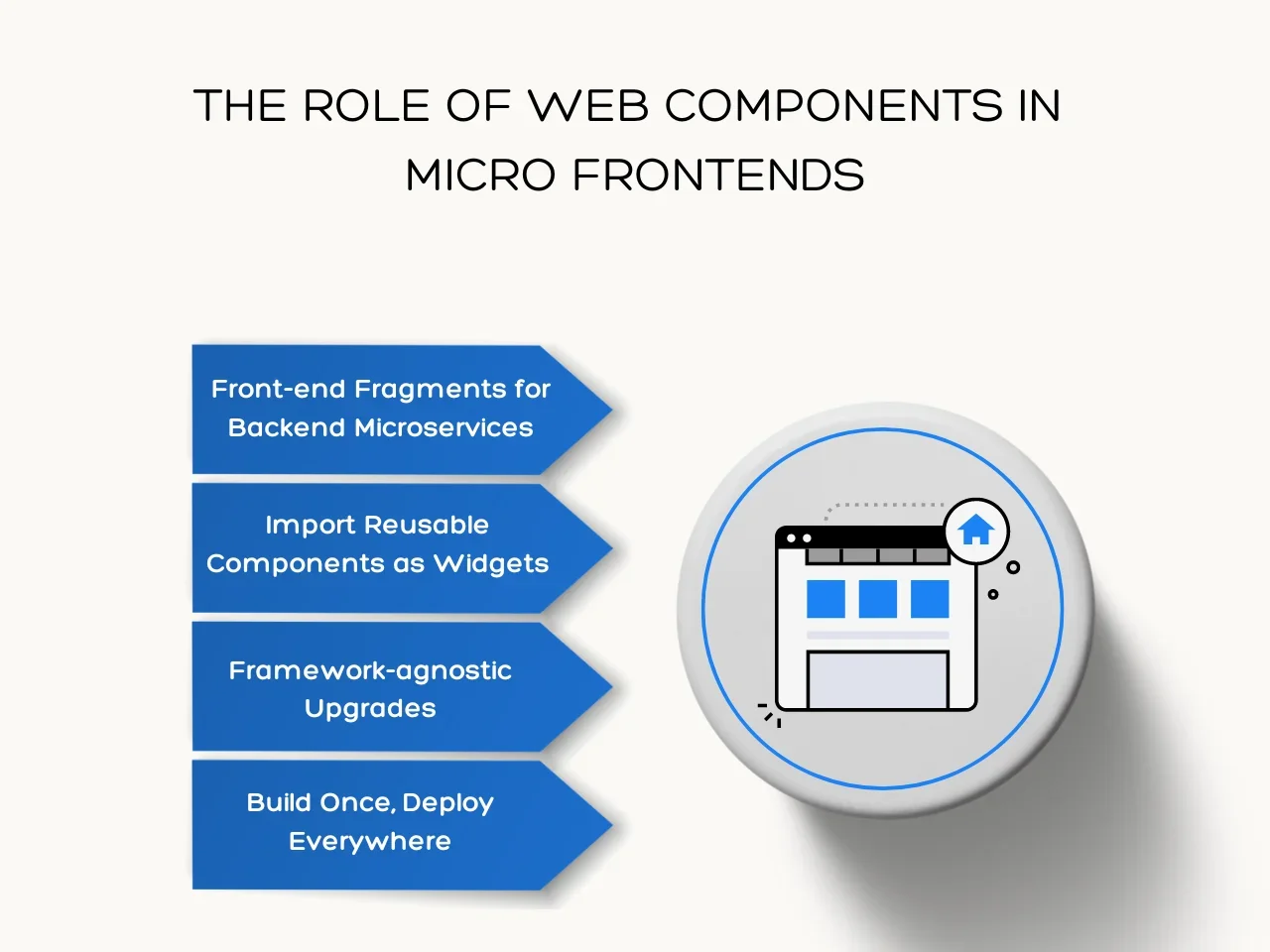
Web Components are key to micro frontend architecture because they enable the creation of reusable, encapsulated UI components. These components work across various frameworks and libraries to consistently reduce dependency conflicts. Each micro frontend can be deployed as a separate .js file, allowing it to operate independently. However, since each component includes its framework, it can become large and affect performance, requiring close performance monitoring.
Furthermore, Web Components offer various other benefits, such as:
- Enabling the creation of front-end fragments that can be packaged with a backend microservices approach;
- Allowing reusable components to be imported as widgets into any web page;
- Simplifying site upgrades by being framework-agnostic and reusable across different frameworks;
- Letting developers build once and deploy everywhere, bringing component-based design to web applications.
Implementing Micro Frontends with Module Federation
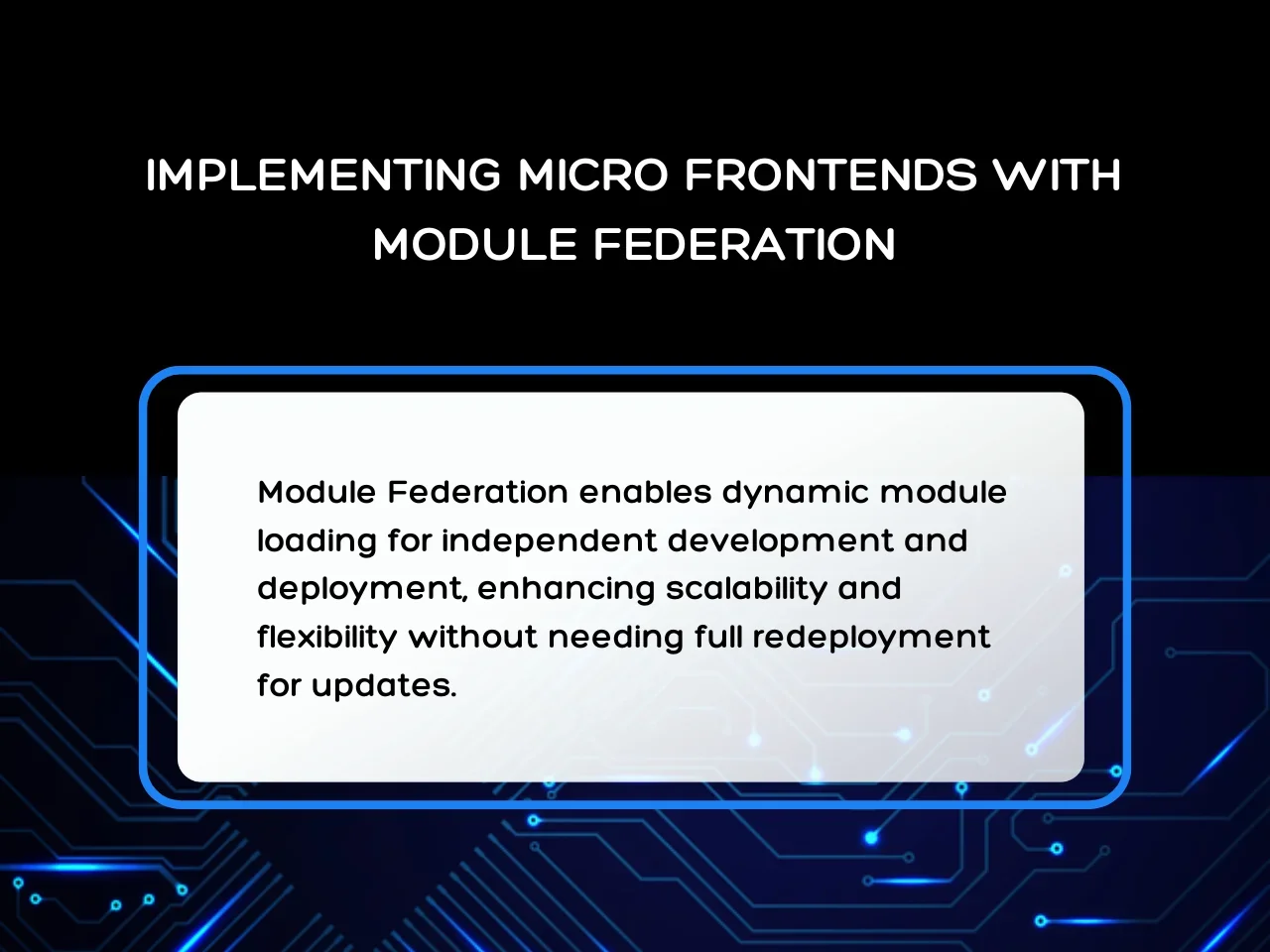
Module Federation supports runtime integration by dynamically loading modules, allowing for independent development and deployment. This improves scalability and flexibility, as updates to one module don’t require redeploying the entire application. It also facilitates sharing common libraries, optimizing performance, and reducing bundle sizes.
Released with Webpack 5, Module Federation helps micro frontends appear as a single application. It allows micro frontends to be loaded into a main application at runtime, with only integration contracts needed, making it easy to customize and adapt components for different clients. This approach ensures a modular architecture and consistent standards across applications.
Advantages of Using Iframes and NPM Packages
Iframes isolate micro frontends by embedding each in its own frame, with a single page application (SPA) coordinating them. On the other hand, NPM packages allow the SPA to release and integrate each micro frontend independently. This setup simplifies integration but can create challenges with dependency management and cross-team coordination.
Advantages of Using Iframes
- Technology Agnosticism: Allows the use of different technology stacks, making it easier to integrate different systems.
- Security: Provides a sandboxed environment, enhancing security by isolating interactions.
- Simplicity: Easy to integrate with a simple setup using the src attribute.
Advantages of Using NPM Packages
- Modular Development: Enables independent development, testing, and deployment.
- Code Reuse and Shared Services: Promotes reuse and consistency through centralized shared components.
- Easy Rollback: Simplifies version control and rollback to previous versions if needed.
Benefits of Adopting Micro Frontends
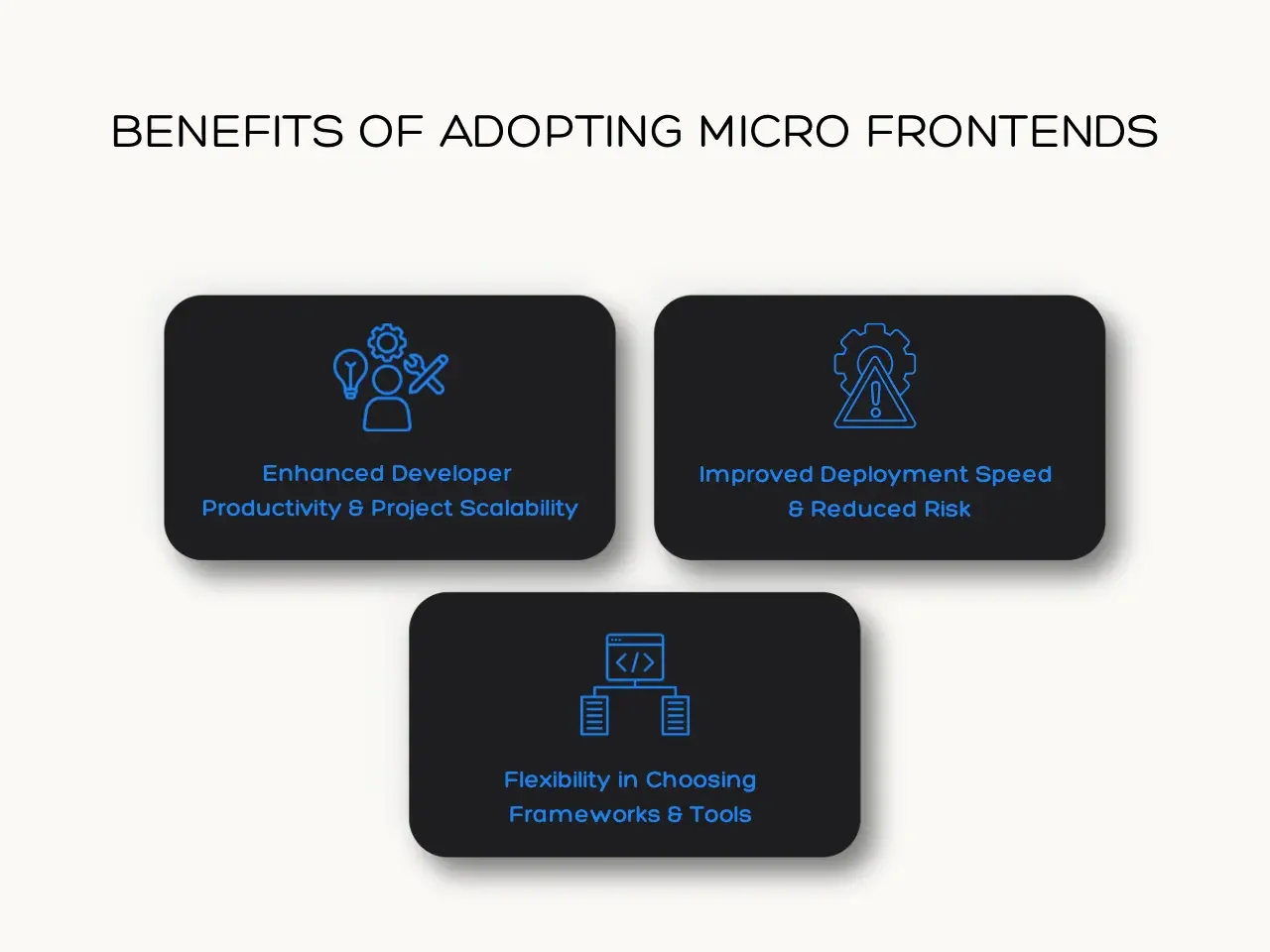
Adopting micro frontends brings several advantages that can significantly enhance your development process. We’ve outlined them below:
Enhanced Developer Productivity and Project Scalability
Micro frontend architecture enhances developer productivity and project scalability in different ways.
Micro frontends break down a monolithic application into smaller, independently manageable components. This allows teams to work autonomously, make quicker decisions, and deploy changes without waiting for other application parts to be ready. This decentralized approach also enables the simultaneous development of new features, reducing bottlenecks and increasing efficiency.
In terms of project scalability, micro frontends support independent deployments and scaling of specific components, minimizing the risk of affecting the entire application. This modular approach allows for flexible technology stacks, improved testing, and easier maintenance, ensuring the project can grow and adapt seamlessly.
Improved Deployment Speed and Reduced Risk
Micro frontends improve deployment speed and reduce risk by splitting a large frontend into smaller, independent units. This lets different teams work on different parts of the application simultaneously, facilitating the deployment of completed components without waiting for others.
If an issue arises, it only affects the specific part of the system, making it easier to fix without disrupting the whole application. For example, companies can update their user profile and shopping cart features separately. A bug in the shopping cart can be fixed without affecting the user profile, minimizing downtime and risk.
Flexibility in Choosing Frameworks and Tools
A micro frontend framework comprises a shared library and tools that simplify developing, integrating, and deploying modular, scalable web applications by enabling independent frontend modules. Here are some noteworthy frameworks that developers can use:

- Bit: Allows teams to create and manage frontends as independent components with a component-driven CI/CD process, ensuring fast and neutral builds.
- Luigi: Helps decompose monolithic web apps into modular micro frontends with smooth communication and flexible technology choices.
- Module Federation: Offers flexibility in handling micro frontends, managing code dependencies, and enabling parallel loading for efficient module sharing.
- Open Components: Adds client-side functionality with JavaScript, HTML, and CSS and includes server-side logic through Node.js, offering flexibility across different environments.
- Piral: Facilitates the building of portal applications using decoupled modules (Pilets) and offers community-driven, open-source support.
- Qiankun: Builds on Single-Spa, offering enhanced functionality, style isolation, and sandboxing for secure, mixed-framework development.
- Single-Spa: A JavaScript router that supports multiple frameworks on the same page, allowing for coexistence and flexible development.
- SystemJS: Provides fast, near-native module loading and supports various JS module features, including import maps and dynamic imports.
Key Takeaway
Micro frontends are redefining web development approaches, especially for large-scale e-commerce platforms and complex enterprise dashboards. These micro frontends foster enhanced team collaboration by working on various parts of the front end. This approach drives rapid development and creates more resilient applications. It’s the solution to building scalable and manageable web apps, which favors startup and enterprise developers.
However, micro frontends also present challenges. They can introduce integration, consistency, and performance issues requiring careful team planning and training. Ultimately, while a micro frontend offers a promising solution to the limitations of monolithic architectures, developers must weigh the benefits against their drawbacks to determine if they align with their project’s requirements and complexities.
Ready to experience the advantages of micro frontend architecture without disrupting your workflow? Aloa is a software agency with a network of highly vetted partners who excel in micro frontend solutions. With transparent performance reports and continuous support, we can ensure seamless integration and effective coordination within your project. Contact us via [email protected] to revolutionize your software development.

